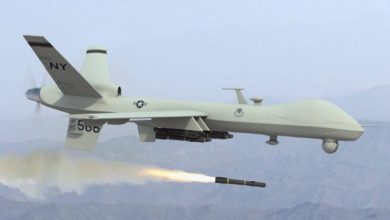Defense Innovation Unit seeks systems to counter Red Sea drone attacks

As Iran-backed Houthi rebel groups continue to use attack drones to target ships in the Red Sea, the U.S. Navy and the Defense Innovation Unit are partnering to prototype a counter uncrewed aircraft system that can disable or shoot them down.
The Navy is looking for a system it can easily integrate with a range of platforms to defend against such adversary drone attacks, DIU said June 14. The program, dubbed Counter NEXT, aims to quickly test prototypes and field them on vessels around the globe.
“It is expected that solutions will be capable of expeditious worldwide deployment, integrated with a variety of naval platforms and must display the ability to be easily integrated into the existing sensors onboard a naval vessel,” DIU said in a statement.
Since last fall, Iran-backed groups have used drones, uncrewed surface vessels and anti-ship ballistic vehicles to launch dozens of attacks on U.S., allied and commercial shipping vessels in the Red Sea. The incidents have disrupted global trade in key waterways and killed three merchant sailors.
According to a June 13 report from the Defense Intelligence Agency, 65 countries and 29 major energy and shipping companies have been affected or have had to alter their routes in response to these aggressions.
“The growing threat of adversarial unmanned aircraft systems (UAS) poses significant risks to U.S., allied and partner forces, naval vessels, and commercial vessels transiting key maritime routes across the globe,” DIU said. “The U.S. is committed to protecting commercial maritime trade and, more importantly, service members conducting maritime operations in contested environments.”
DIU has a portfolio dedicated to leveraging commercial and off-the-shelf technology to defend against these types of drone threats. Matthew Way, who leads that effort, said counter UAS is a high priority for the organization, adding that DIU plans to use a portion of the $800 million budget increase Congress provided in fiscal 2024 to fund efforts like Counter Next.
“We’ve really got to focus on, how do we get after those more advanced capabilities . . . and how do we protect ourselves from adversarial threats that are employing this technology as well,” he said during Applied Intuition’s June 13 Nexus conference in Washington, DC.
Pentagon officials have emphasized that defending against enemy drones will require a layered approach, including electronic warfare and kinetic effects.
Counter Next is focused on kinetic systems that cost less than a traditional missile or air defeat system and rely on mature technology that can be ready for testing within 90 days of a contract award. And while it’s not required, DIU may prioritize proposals that demonstrate the ability to take out surface vessel threats.
Companies must also be able to deliver at least five systems within 12 months of being selected.
Courtney Albon is C4ISRNET’s space and emerging technology reporter. She has covered the U.S. military since 2012, with a focus on the Air Force and Space Force. She has reported on some of the Defense Department’s most significant acquisition, budget and policy challenges.







